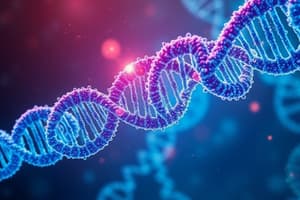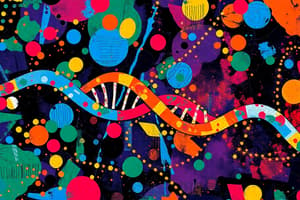Podcast
Questions and Answers
What is the main difference between direct reversal DNA repair and replacement of damaged nucleotide bases?
What is the main difference between direct reversal DNA repair and replacement of damaged nucleotide bases?
- Direct reversal is specific to UV light damage, while replacement is more general.
- Direct reversal is slower than replacement.
- Direct reversal does not require a template, while replacement requires a template. (correct)
- Direct reversal requires a template, while replacement does not.
Which enzyme is responsible for photoreactivation in direct reversal DNA repair?
Which enzyme is responsible for photoreactivation in direct reversal DNA repair?
- Polymerase
- Photolyase (correct)
- Helicase
- Methyltransferase
Why is direct reversal through photoreactivation not possible in humans?
Why is direct reversal through photoreactivation not possible in humans?
- Humans lack the enzyme required for photoreactivation. (correct)
- Humans are not capable of repairing DNA damage.
- Humans do not have the necessary light exposure.
- Humans do not form pyrimidine dimers.
What is the function of the protein MGMT in direct reversal DNA repair?
What is the function of the protein MGMT in direct reversal DNA repair?
Which type of DNA damage does photoreactivation specifically address in direct repair?
Which type of DNA damage does photoreactivation specifically address in direct repair?
What is the result of methylation of guanine bases in DNA?
What is the result of methylation of guanine bases in DNA?
Which enzyme accepts the alkyl group through its sulfur atom of a cysteine residue?
Which enzyme accepts the alkyl group through its sulfur atom of a cysteine residue?
What happens to the enzyme once it transfers the alkyl group?
What happens to the enzyme once it transfers the alkyl group?
What term is used to describe an enzyme that becomes inactivated upon accepting an alkyl group?
What term is used to describe an enzyme that becomes inactivated upon accepting an alkyl group?
Which repair mechanism involves the recognition and removal of a single damaged base?
Which repair mechanism involves the recognition and removal of a single damaged base?
What enzyme family is required for the base excision repair mechanism?
What enzyme family is required for the base excision repair mechanism?
Which repair mechanism is used to repair damage to DNA caused by the formation of pyrimidine dimers from UV light?
Which repair mechanism is used to repair damage to DNA caused by the formation of pyrimidine dimers from UV light?
What is formed after glycosylases enzymes remove a damaged base during the repair process?
What is formed after glycosylases enzymes remove a damaged base during the repair process?
Excision repair involves the removal and replacement of damaged DNA on which strand?
Excision repair involves the removal and replacement of damaged DNA on which strand?
"Nucleotide Excision Repair" recognizes what type of damage before initiating the repair process?
"Nucleotide Excision Repair" recognizes what type of damage before initiating the repair process?
Flashcards are hidden until you start studying




